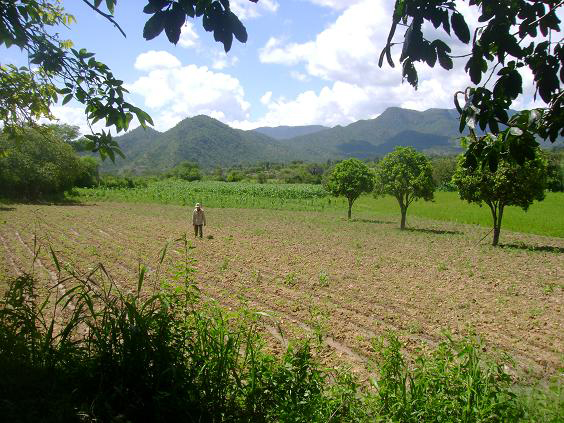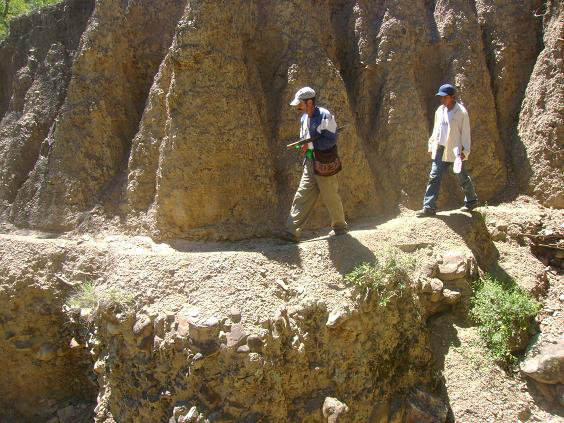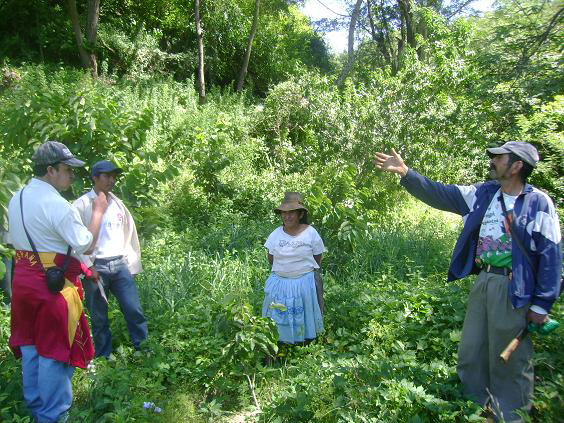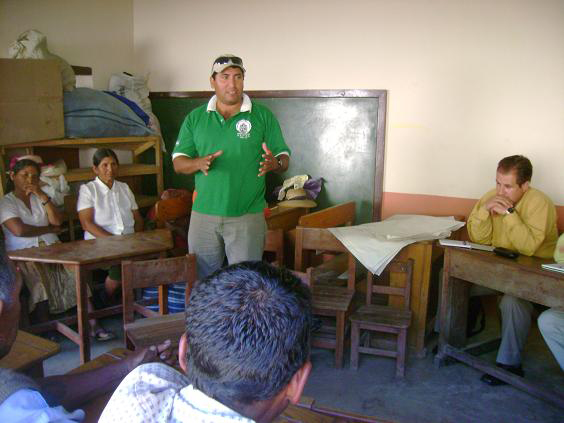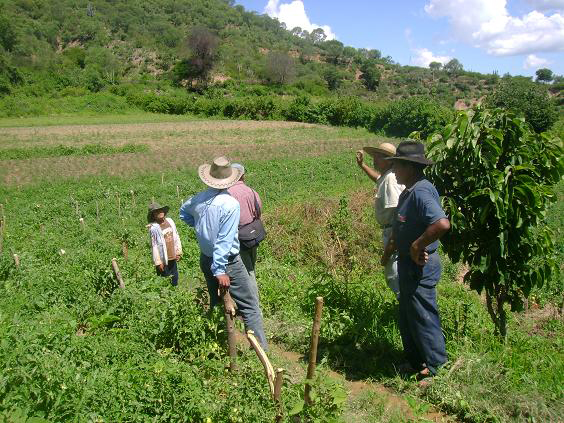Community-Based Adaptation: Bolivia
Project Overview
Climate change impacts in Bolivia will vary with the country's diverse topography and ecology, but will include the following:
- Rising temperatures, particularly in high-altitude zones
- Retreat and disappearance of mountain glaciers
- Increasingly erratic and intense rainfall
- Increased aridity in the some regions
- Increased streamflow variability
- Increased risk of erosion, landslides
- Altitudinal shift in natural and agro-ecosystem zones
Community-Based Adaptation projects in the country focus on rural livelihoods and ecosystems in the context of water, agriculture and health, in the face of flood, drought and erosion due to climate change. Activities will be guided by the Bolivia CBA Country Programme Strategy (English Abstract).
All CBA projects involve non-governmental organizations (NGO) at the local and national levels. In addition, the UN Volunteers is a project partner in seven (7) out of the ten (10) CBA countries: Bolivia, Guatemala, Jamaica, Morocco, Niger, Namibia, and Samoa. In addition to the Adaptation & Volunteerism Specialist overseeing the seven (7) countries, a national UNV officer in Bolivia is fully dedicated to the CBA projects at the local level. The partnership began in June 2009.
Bolivia's CBA portfolio includes a total of six (6) projects:
1. Water Source Protection and Soil Conservation through Reforestation in Batallas Municipality
2. Participatory Adaptation Learning to Reduce Food Insecurity in Ancoraimes
3. Sustainable Management of the Cherimoya Crop for Climate Change Adaptation in Saipina
4. Knowledge and Tools for Sustainable Management of Water and Soils in Moro Moro
5. Rural Water and Climate Risk Management in the Alto Seco Area
6. Recovery of Tarwi Seeds for Adaptation in the Carabuco Municipality Near Lake Titicaca
* Bolivia is one of ten (10) countries implementing projects as part of UNDP's "Community-Based Adaptation" programme. *
Project Details
The effects of climate change will significantly impact the livelihoods of rural poor communities in Bolivia. Increasing temperatures, increasingly variable precipitation, melting glaciers and consequently altered hydrology will have significant impacts on the ecosystems upon which people rely for agriculture, water, and other vital goods and services – threatening biodiversity, increasing land degradation pressures, and threatening progress toward the Millennium Development Goals.
In response, the CBA project in Bolivia will build community-level capacity to adapt to climate change by integrating climate change risk management practices into community management of agro-ecosystems, water, soils, and crop genetic resources. Through these activities and through the development of strategic partnerships, CBA project activities will increase the resilience of land and biodiversity resources to the impacts of climate change.
CBA-supported community projects in Bolivia will focus on three key areas:
Food security/agriculture: CBA-Bolivia projects in agriculture will focus on adaptation to increasing temperatures and increasingly variable rainfall. CBA projects will focus on interventions that more effectively manage indigenous agro-biodiversity in response to climate-driven erosion and pressures on critical crop yields.
Water Resources: CBA-Bolivia projects in water resource management will seek to manage changing hydrology stemming from of increasing glacier melt-driven flood and drought risk, as well as increasing rainfall variability and evapotranspiration. In doing so, projects will reduce growing erosion risks and contribute towards sustaining rural livelihoods.
Natural Ecosystems: CBA-Bolivia projects will also pilot community based approaches to managing biodiversity and maintaining vegetative cover in the face of climate-driven species migration. Projects will seek to reduce climate-driven pressures on threatened species and key ecosystems.
CBA projects will be focused in two key regions in Bolivia –near Lake Titicaca, and in the Crucenos Valleys.
Climate Change Projections for Bolivia
Climate change projections for Bolivia include increased temperatures, increasingly variable rainfall, leading to severe glacial melting, rapidly changing mountain ecosystems, and declining water availability. Temperatures are predicted to increase steadily, increasing by 3°C or more during the 21st century, with increases concentrated in the main dry season. Significant glacial melting is likely to increase risks of flood and water shortage, as declining glaciers are less able to store water for steady release throughout the year.
Increasing evapotranspiration driven by temperature increases, in combination with increasing rainfall variability, is likely to decrease water availability significantly, and increase the proportion of drought years.
Climate change impacts in Bolivia will vary considerably with altitude, affecting diverse microclimates differently. In addition, climate change trends will be superimposed over the ongoing context of inter-annual climate variability related to the El Niño Southern Oscillation.
Key Results and Outputs
CBA-supported community projects in Bolivia will focus on three key areas:
Food security/agriculture: CBA-Bolivia projects in agriculture will focus on adaptation to increasing temperatures and increasingly variable rainfall. CBA projects will focus on interventions that more effectively manage indigenous agro-biodiversity in response to climate-driven erosion and pressures on critical crop yields.
Water Resources: CBA-Bolivia projects in water resource management will seek to manage changing hydrology stemming from of increasing glacier melt-driven flood and drought risk, as well as increasing rainfall variability and evapotranspiration. In doing so, projects will reduce growing erosion risks and contribute towards sustaining rural livelihoods.
Natural Ecosystems: CBA-Bolivia projects will also pilot community based approaches to managing biodiversity and maintaining vegetative cover in the face of climate-driven species migration. Projects will seek to reduce climate-driven pressures on threatened species and key ecosystems.
CBA projects will be focused in two key regions in Bolivia –near Lake Titicaca, and in the Crucenos Valleys.
Reports and Publications
CBA Inception Workshop, July 2009 - Presentation on CBA in Bolivia (Juan Carlos Soria)
Brochures, Posters, Communications Products
Community-Based Adaptation: Climate Change in Action brochure (2009)
Community-Based Adaptation: Climate Change in Action brochure (Jan. 2010)
Community-Based Adaptation to Climate Change Brochure (July 2010)
ProDocs
CBA Bolivia - Country Programme Strategy abstract (English)
Project Brief / Fact Sheet
PIFs
Multimedia
TARWI: The Seeds of the Future (Spanish)
TARWI: The Seeds of the Future
A Participatory Video from a UNDP-GEF CBA project in Bolivia
October 2010
CBA Bolivia - Semillas del Futuro Vol.1
Recovery of tarwi (Lupinus Mutabilis S.) seeds in four communities of the Carabuco Municipality near Lake Titicaca
CUNA Association
Monitoring and Evaluation
Monitoring and evaluation for community-based adaptation is a new field, and the CBA project is piloting innovative approaches to evaluating the success of locally-driven adaptation projects, and generating lessons to inform ongoing practice.
Key considerations in M&E for CBA include:
- Grounding M&E in the local context: M&E for CBA should avoid overly rigid frameworks, recognizing community heterogeneity and maintaining local relevance
- Capturing global lessons from local projects: CBA projects are highly contextualized, but lessons generated should be relevant to stakeholders globally
- Incorporation of both quantitative and qualitative indicators: to ground projects in tangible changes that can be objectively evaluated, and to capture lessons and case studies for global dissemination
To these ends, the CBA project uses three indicator systems: the Vulnerability Reduction Assessment, the Small Grants Programme Impact Assessment System, and the UNDP Climate Change Adaptation Indicator Framework.
The Vulnerability Reduction Assessment (VRA)
The VRA is a question-based approach with the following aims:
- To make M&E responsive to community priorities
- To use M&E to make projects more accountable to local priorities
- To make M&E capture community ideas and local knowledge
- To gather community-level feedback to guide ongoing project management
- To generate qualitative information
- To capture lessons on specific issues within community-based adaptation
- To generate case studies highlighting adaptation projects
The VRA follows UNDP's Adaptation Policy Framework, and is measured in a series of meetings with local community stakeholders. In these meetings, locally-tailored questions based on standard VRA questions/indicators are posed, and the community assigns a numerical score on a 1-10 scale for each question. Progress is evaluated through changes in scores over the course of implementation, as well as through qualitative data collected in community discussions surrounding the exercise.
UNDP has developed a Users Guide to the VRA (Espanol) (Francais) as a tool to assist practitioners to conceptualize and execute VRA measurements in the context of CBA projects.
The SGP Impact Assessment System (IAS)
The CBA, being a project of the GEF Strategic Priority on Adaptation, aims to increase the resilience of ecosystems and communities to the impacts of climate change, generating global environmental benefits, and increasing their resilience in the face of climate change impacts. To this end, the CBA projects use the SGP's impact assessment system for monitoring achievements in GEF focal areas (focusing primarily on biodiversity and sustainable land management).
The IAS is composed of a number of quantitative indicators which track biophysical ecosystem indicators, as well as policy impact, capacity development and awareness-building.
UNDP Climate Change Adaptation Indicator Framework
CBA projects also track quantitative indicators from UNDP's adaptation indicator framework, corresponding to the thematic area on natural resources management. More information on UNDP's indicator framework can be found on the UNDP climate change adaptation monitoring and evaluation website.
* This description applies to all projects implemented through UNDP's Community-Based Adaptation programme. Specific details on this project's M&E will be included here as they become available. *
